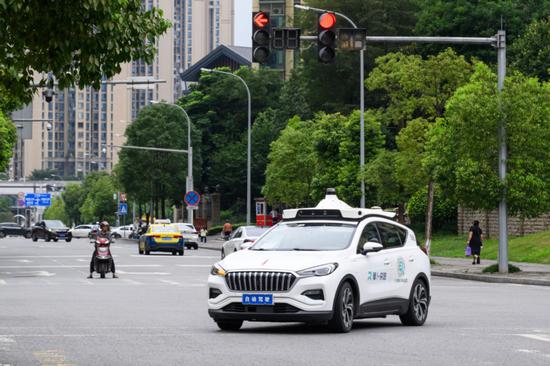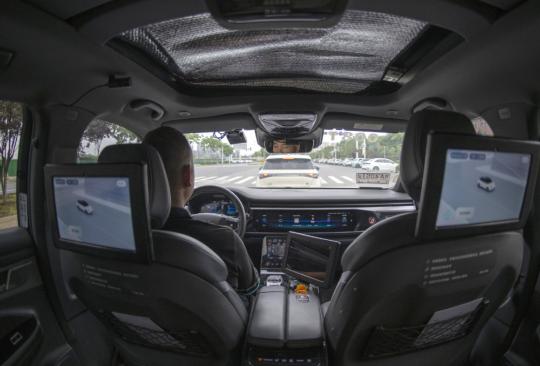Self-driving to revolutionize transportation
When Wu Zhenpeng, a 32-year-old IT engineer from Wuhan, capital of Hubei province, hailed a self-driving taxi to reach home after work, all he had to input on the ride-hailing app was the pickup and drop-off points and the number of passengers.
A few minutes later, a robotaxi approached, with no driver or safety operator sitting in, and soon Wu was on his way back.
The driverless vehicle operated smoothly without sudden braking or acceleration, Wu said. "When there is a traffic jam, the car automatically replans routes and switches to the most convenient path, with an average speed of about 65 kilometers per hour. I think there is no difference between this driverless car and cars with drivers."
"It usually costs about 29 yuan ($4) from my workplace to home using a traditional taxi; however, because of various subsidies and discounts, I need to pay only 8.2 yuan for a robotaxi ride," Wu added.
The large-scale commercial use of self-driving technology could become a reality sooner than expected, and is likely to revolutionize urban transport due to their greater efficiency and lower costs, industry experts said.
However, the fast-developing technology still faces some challenges and limitations, including how to ensure safety and reliability, especially in complex scenarios, and public concerns over job losses for regular taxi drivers.
The market scale of robotaxis in China is expected to exceed 1.18 trillion yuan in 2025 and 2.93 trillion yuan in 2030, making it one of the largest application scenarios for autonomous driving technology, according to a report by Pacific Securities.
China has taken the lead in the research and development as well as application of autonomous driving technology, and has introduced a series of policies to promote the commercialization of self-driving vehicles in recent years.
The Ministry of Industry and Information Technology as well as four other central government departments selected 20 cities, including Beijing, Shanghai and Chongqing, earlier this month to participate in a pilot program on "vehicle-road-cloud integration" for intelligently connected vehicles.
The move aims to connect intelligent vehicles with environmental and cloud-based control systems, paving the way for enhanced safety and efficiency in autonomous driving technology.
China supports the commercial application of Level 3 and above autonomous driving systems, as part of the country's broader push to bolster the development of intelligently connected vehicles, according to the MIIT.
Currently, autonomous driving is categorized from Level 0 to Level 5;the higher the level, the more intelligent the technology. Level 3 means conditional automation, in which a vehicle can drive by itself under certain conditions.
More than 50 cities nationwide have released autonomous driving pilot demonstration policies, and stepped up efforts to expand the application scenarios of self-driving technology.
The Beijing municipal government recently announced plans to support the use of autonomous driving vehicles for urban public electric bus transportation, ride-hailing services and car rentals.
The Beijing Municipal Bureau of Economy and Information Technology released the draft regulation for public feedback on self-driving vehicles on June 30. The bureau said the regulation aims to provide clear, transparent and predictable institutional norms for market entities operating Level 3 and above autonomous vehicles, while maintaining safety as the top priority.
Beijing has taken the lead in planning and constructing the country's first high-level automated driving demonstration zone since September 2020, and released self-driving road test licenses to 31 companies, with the total testing mileage of autonomous vehicles surpassing 28 million kilometers.
In February, the capital granted permits to several robotaxi operators, including Baidu and Pony.ai, allowing them to offer driverless vehicle services at Beijing Daxing International Airport, a key step indicating that the city has become the world's first capital to run autonomous passenger vehicles between urban areas and the airport.
Shanghai will soon begin public testing of autonomous driving ride-hailing vehicles on some designated roads in the Pudong New Area, offering free rides for local residents throughout the trial period. The city granted demonstration licenses for driverless intelligently connected vehicles to four self-driving companies in early July.

An autonomous car operates on urban roads in Chongqing on July 10. [HE PENGLEI/CHINA NEWS SERVICE]
Quick deployment
Lyu Jinghong, an analyst tracking intelligent mobility at research company BloombergNEF, said continued tests on public roads, eased regulations, as well as cost reductions in autonomous vehicle manufacturing, will help accelerate the deployment and commercialization of self-driving vehicles.
Noting that China had caught up with the United States in developing autonomous driving, Lyu said clear national-level regulations will encourage local governments and autonomous driving companies to quicken the use of self-driving technology, which is crucial for achieving commercialization targets.
According to BloombergNEF's 2022 Electric Vehicle Outlook, China will operate the world's largest robotaxi fleet with some 12 million autonomous vehicles by 2040, followed by the US, with about 7 million such vehicles.
Chinese technology companies have been striving to advance the technology and accelerate the commercial use of autonomous driving vehicles.
Tech heavyweight Baidu Inc's fully autonomous driving robotaxis, with no driver or safety operator inside, are now operating in some designated areas of Beijing, Chongqing, Wuhan and Shenzhen, Guangdong province. In case of an emergency, a remote safety supervisor takes control of the vehicle via an online assistance platform.
Wuhan is stepping up efforts to promote the development of intelligently connected vehicles and commercialization of driverless technology, boasting the largest operational region for Baidu's autonomous ride-hailing platform Apollo Go.
The Beijing-based company said it has more than 500 robotaxis running in Wuhan and expects to increase that number to 1,000 by the end of this year. It plans to expand its fleet size and service area nationwide and build the world's largest fully driverless ride-hailing area.
With decreasing costs and increasing orders, Apollo Go is expected to turn profitable by 2025, Baidu said.
In the first quarter, Baidu's Apollo Go provided about 826,000 rides, up 25 percent year-on-year. As of April 19, the cumulative rides provided to the public by Apollo Go surpassed 6 million, the company said in its latest financial results.
Chinese self-driving startup Pony.ai is stepping up efforts to launch robotaxi services in an attempt to bolster large-scale commercial use of growing transportation solutions.
The company said earlier this month that it has received permits to operate fully driverless robotaxis, in which no safety supervisors are present, in a 205-kilometer route in the Pudong New Area. Prior to receiving approval in Shanghai, Pony.ai had already obtained licenses for fully driverless robotaxi services in Beijing, Guangzhou, and Shenzhen.
Global consulting firm McKinsey& Company has forecast that China will become the world's largest market for self-driving vehicles, with revenue from such vehicles and mobility services exceeding $500 billion by 2030.
Li Xinbo, an automotive industry expert at China Auto Information Technology Co, said greater efforts are needed to strengthen construction of intelligent transportation infrastructure, such as the 5G-enabled vehicle-to-everything or V2X system, which supports the transfer of information from a vehicle to moving parts of the traffic system to improve efficiency.
However, a self-driving taxi operated by Baidu recently hit a pedestrian crossing a traffic light in Wuhan, sparking heated discussions online about the challenges facing autonomous driving technology.
Some local residents have also complained that autonomous driving cars cause traffic jams by driving slowly and stopping unexpectedly.
Zhang Xiang, an auto sector researcher at North China University of Technology, said the incident in Wuhan indicates that although self-driving technology has advanced significantly over the past few years, it still encounters difficulties under complicated and ever-changing road conditions and faces limitations while handling unconventional behavior, such as motorists or pedestrians violating traffic rules.
Noting that the nationwide, large-scale commercialization of autonomous driving technology will take about 10 years, he said that "ensuring the safety and stability of robotaxis remains a top priority."
Zhang said more efforts are required to enhance self-driving testing and application scenarios, continuously optimize algorithms, reduce the manufacturing costs of driverless vehicle components, as well as strengthen the construction of intelligent transportation infrastructure.
Moreover, the rising prominence of robotaxis in more Chinese cities has raised concerns about employment, as taxi drivers are worried about losing their jobs given that robotaxis are typically cheaper than traditional ones.
"Currently, driverless cars will not pose a challenge to the traditional taxi sector because people are only inclined to experience this emerging technology, and the number of robotaxis on the road is still far fewer than regular taxis," said Pan Helin, a member of the MIIT's Expert Committee for Information and Communication Economy.
He said the pressure on taxi drivers mainly comes from intense competition between private ride-hailing cars and traditional taxis, adding that autonomous driving vehicles will not either seriously impact the job market or replace human drivers in the short term.
Gu Dasong, executive director of the Southeast University's Research Center for Transportation Law and Development, said commercial operation of self-driving ride-hailing vehicles might reduce the need for traditional drivers, such as taxi drivers and freight drivers, to some extent over the long term.
However, this replacement involves the upgrading of employment structure, rather than the disappearance of jobs, and it will profoundly transform the labor market, given that new job opportunities might come with the rising robotaxi services, Gu added.

